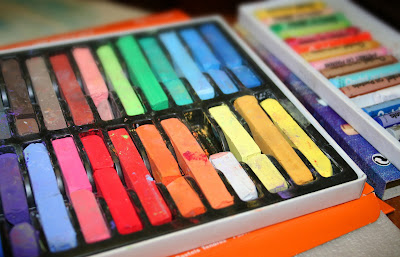
Before you start a new piece:
1.Get out your workbook and start making some plans. These plans can involve life sketches, dreams, abstract thoughts, various exercises, clippings, poems, images you like, favourite songs etc. Allow your workbook or file to become a collection of things that inspire you. Whenever you get stuck for ideas, you'll find it can become your most valuable asset.
2.Remember that you do not always need a perfect plan! Planning a painting or drawing can just as easily inhibit spontaneity so sometimes allow the artwork evolve on it own.
3.Once you've decided on a subject or theme you will need to find a support. The shape and size of your canvas will influence the way it is viewed, for example a painting of a vast landscape will be viewed different on a large canvas than how it will be viewed on a small 10cm x 5cm canvas. Large scales tend to impress and overwhelm the viewer while small scales draw the viewer in. Do not simply work on a specific canvas size simply because it is all you have, make sure it is a conscious decision. To help you decide, imagine the reaction you want from your audience. What shape of the canvas will best suit the subject matter? Another idea is to try painting on something other than a canvas: Driftwood, a broken plate, a calabash, an old chair, tin or rusted piece of metal. Get creative!
4.This is a good time to make some pre-sketches or pre-paintings in your workbook to decide on colour schemes, composition and size. Do not underestimate the value of these exercises! By simply starting a painting, even if you've had much success in the past, you limit yourself and remove the possibility that you could have improved on your original idea or concept. Impulsive or spontaneous paintings do not need much planning.
5.Decide on the technique you are going to use and how it will support your idea. Do you want your painting to be full of drama, mystery, excitement or peace? Should it be bright and cheery, somber, sad or realistic? Should the paint be applied thickly (impasto), should you use a dry brush lightly over dry paint (scumbling), scratch into the paint (sgraffito) or paint thin and delicately? The combination of the shape, size, medium, material, colour and technique will determine the mood of your art work.While you may think that this is a lot think about, the awards will be evident in the final piece.
6.What colour palette will you use? Are you going to work around whatever colours you already have or purchase a new palette? Are you sure you have the colours you need to achieve the right results? Not all colours mix the same!
* One can achieve unity in a series of paintings by working with a limited selection of colour in a particular piece.
* If your colours are too bright, try mixing in a little of the opposite (complimentary) colour and don't forget that black can often create a nasty mix of colours rather than simply making a specific colour darker... try blue!
For example:
green + black = natural dull dark green
blue + black = deep blue
yellow + black = green! (beautiful)
* White might “lighten” a colour, but at the same time removes the chroma (strength) of the colour. To lighten red or orange use lemon yellow instead of white.
* Skintone contains much more than just orange + white or burnt sienna + white, add a touch of green or blue
* Know and practice your colour wheel!! Remember that cool colours recede and warm colours advance. Opposite colours compliment each other and mixes brown.
* You will need at least 2 different reds, 2 different blues and 2 different yellows in your toolbox. Titanium white (Opaque) and Ivory or Lamp black (not much needed). Look out for a great selection of premixed browns like burnt and raw sienna (reds), burnt and raw umbers (blues) and ocres (yellow)... just to mention a few.
Magic must have's: Prussian blue, Alizarin Crimson and Lemon yellow.
Also: mixing your own secondary (purples, oranges and greens) and tertiary (browns) colours can be very rewarding!
7.You can now start by painting a layer of colour over your canvas and then loosely sketch your image using a brush or pastel.
Happy painting,
Kenosis
No comments:
Post a Comment